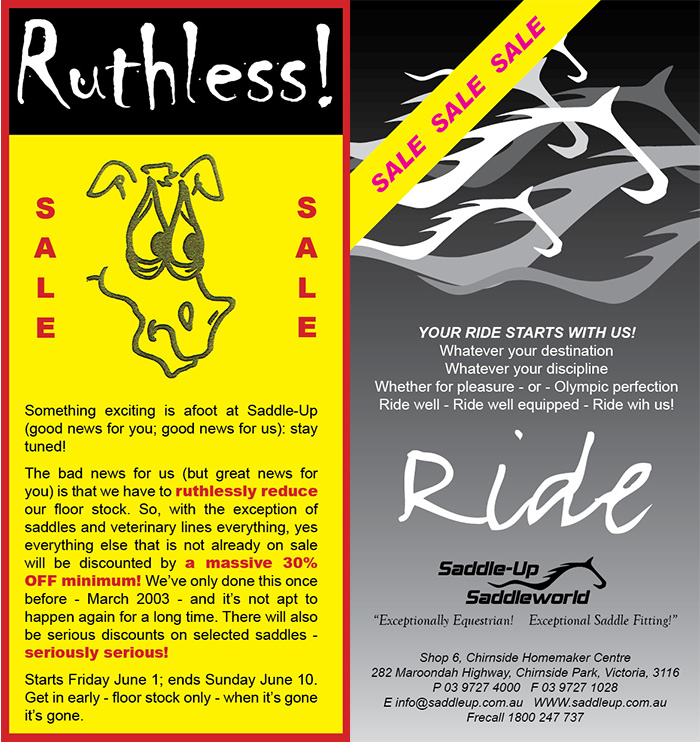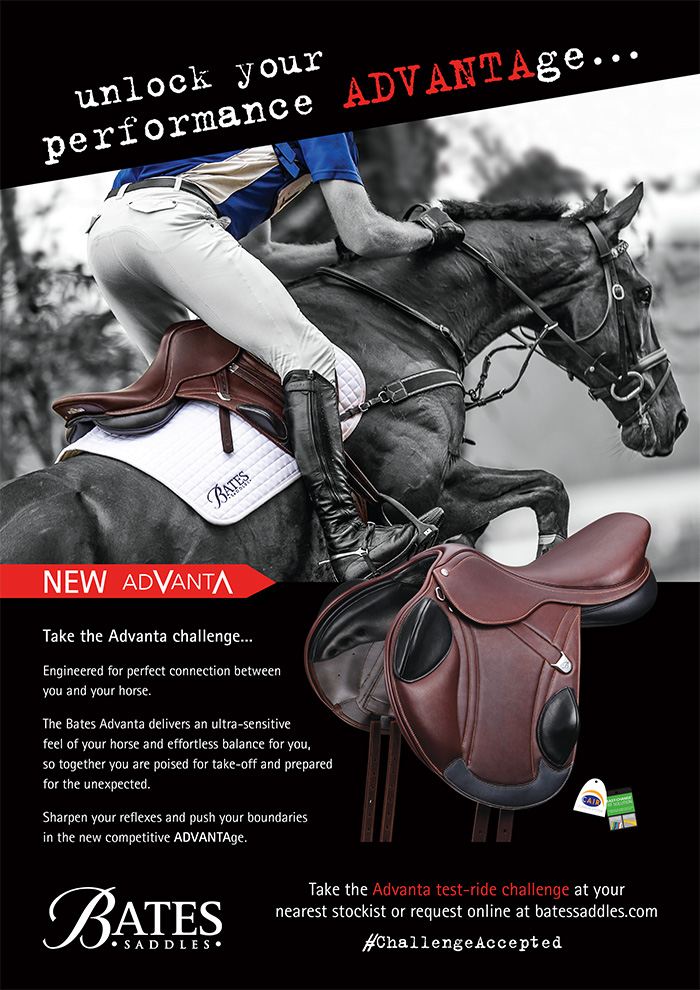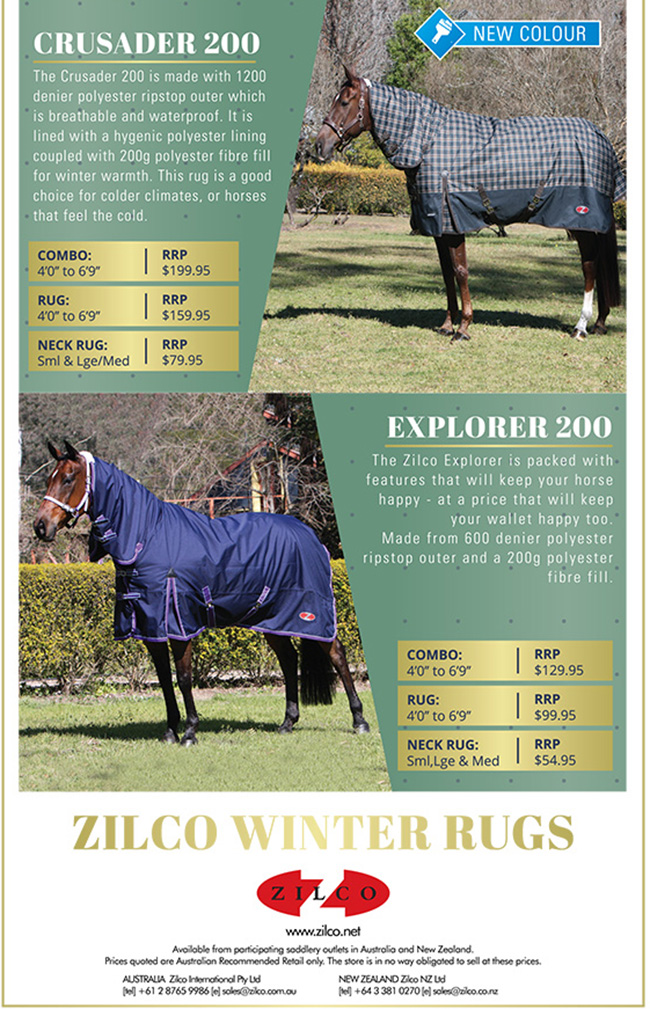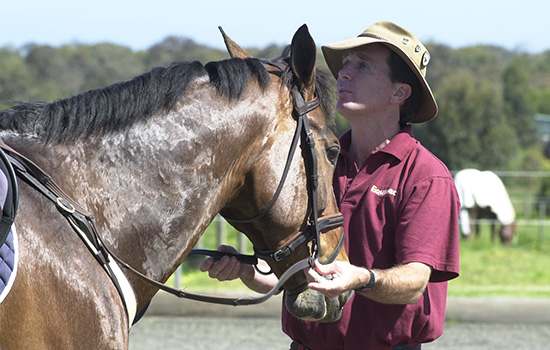
Read Part One here: http://www.horsemagazine.com/thm/2018/05/the-matt-ryan-makeover/
So far Olympic gold medallist, Matt Ryan has helped event rider, Natalie Davies at Adelaide 3DE where she and her horse, AEA Rex went very well, placing eighth. Now after a video de-brief comes the moment of truth – the lesson.
Matthew Ryan is in his element. Matt is not just one of the world’s great competition jockeys, he is a thoughtful, inspiring teacher, and he has a clear plan of attack for his lesson with Nat.
But, first things first, Rex has to get warm and loose before the work can begin: “I want to see the horse with its head down on the ground. Confirm to him that we want him to stretch, nose on the ground.
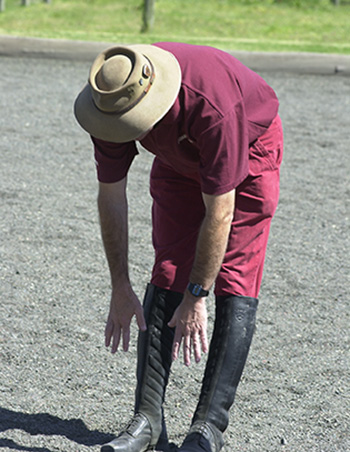
lt’s a bit like an athlete touching his toes before they go off to do a hurdle race, by stretching down as far as they possibly can, all their thigh muscles, rump muscles, get nice and loose – and NOW they can go and do hurdles or whatever.”
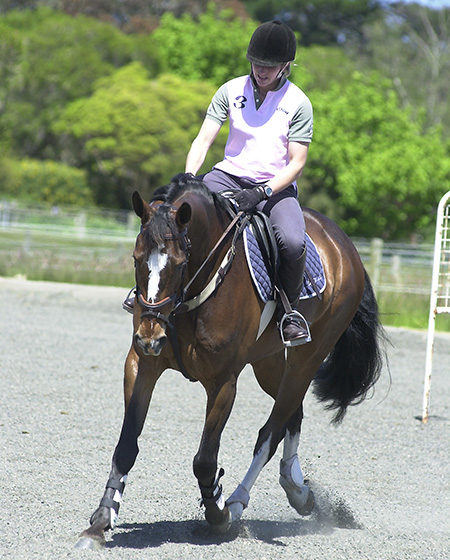
“Think of your first five minutes of warming up like stretching exercises, just like a human athlete would.”
much more follows
“I would recommend this warmup regardless of whether you are doing a jumping session or a flat session. Be concerned about the horse thumping its chin with its front feet. Kick it through, kick it, keep him active and forward. Don’t be concerned about the horse getting overbent when they get down that low. What should happen is when you bring the horse up, the nose then goes to the vertical.”
“We do have to practice things like a free walk on a loose rein where the judges don’t like seeing the horse overbent when they are down that low, so we have to play the game to a degree, but in our gymnastic loosening work, we try and access a horse properly over the back, we still talk about having the horse through the poll.”
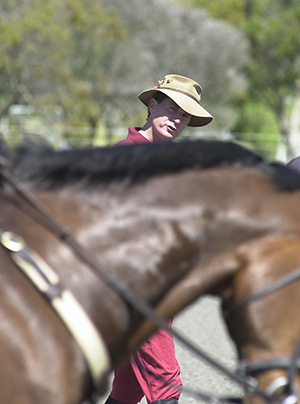
“When you get the horse down low, think about dribbling the horse’s chin down the front of the horse’s legs, don’t let them just poke their nose out – still think of keeping them through the poll by thinking of the horse’s nose dribbling down the front legs. When a horse is overbent, it doesn’t mean – and shouldn’t mean – that the horse is behind the bit. Just because the horse’s shape has his head behind the vertical, it does not mean he is behind the bit. You can tell when a horse is behind the bit from the feeling of them not reaching forward and not reaching down.”
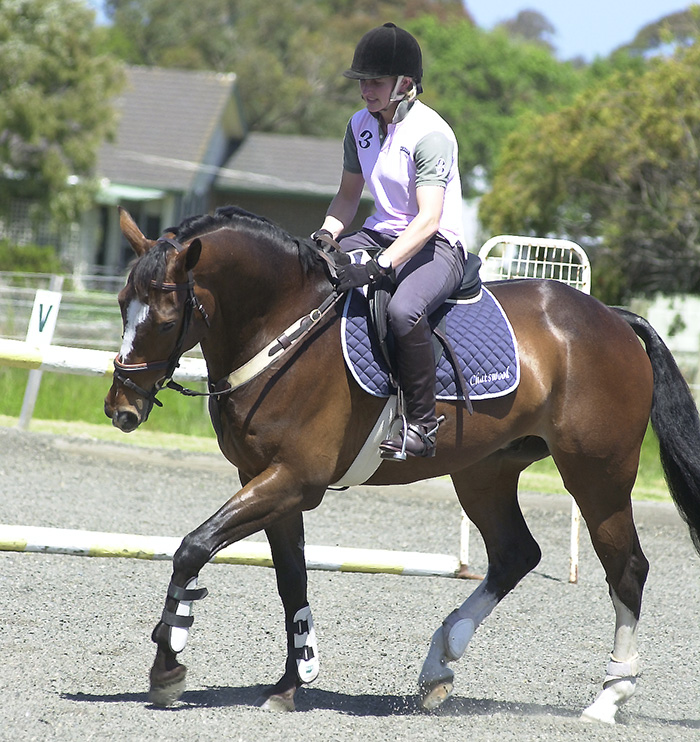
And Rex was not responding to Matt’s satisfaction: “Right now he is not reaching down enough for my liking so five minutes could become ten minutes if I was riding him … ”
“This complicates things because when we looked at the Adelaide test on the video, we said, now the horse has to learn to sit on his rear end a bit more, to collect a bit more. We could think this getting him really low and down is taking a backwards step – it might look like that – but it’s not really, physically you are trying to access the horse’s muscles so it will find sitting on its arse a lot easier.”
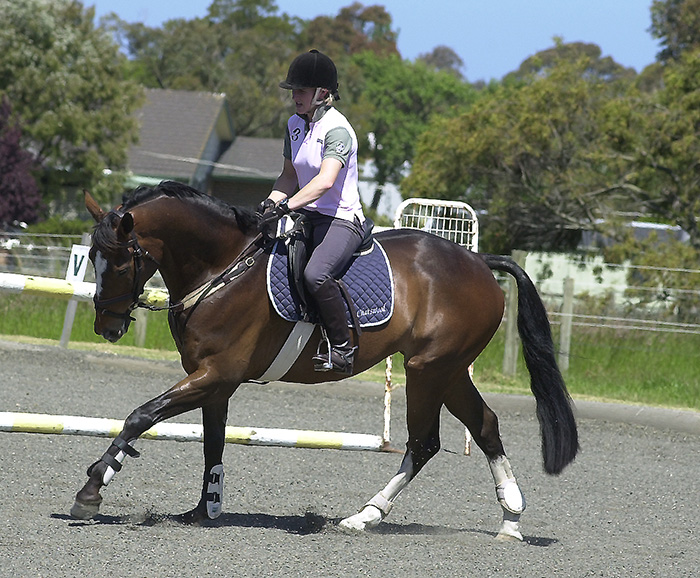
Luckily – because otherwise this might become a very very long working in session, Rex is starting to get the idea: “That’s better, a little more reach, but he hasn’t gone past his chest yet, never mind change the rein, go deeper, the further the better. There are lots of different expressions we can use: the horse reaching down, the horse seeking the contact, the horse lowering itself, all sorts of instructors use all sorts of different terms, they are all trying to do the same thing – get his nose down towards his fetlocks. Make him lower, go soft, don’t be afraid to give a bit more, experiment a little more, half halt, a bit of a hold, a bit of a bend, as long as it is coupled with your leg momentarily beforehand, and then followed by a softening of the hand – that’s just a half halt.”
“Quite often riders forget the third and final part of the half halt, and that is the allowing bit!”
Finally Rex is judged loose enough to start a bit of serious work in canter, although the gelding has decided that rather than work he would like to spook on the little group of spectators that has assembled on the long side…
“Kick him kick him, and get him deeper, if he starts to prick his ears and look at something else you have to get his attention, say ‘listen to me’. Give him an exercise, it might be a little inside leg to go into shoulder in, it might be a little bit of flexion to the outside. Be wary though, if you are thinking of an exercise that involves more contact, just be careful that contact doesn’t over-ride the forwardness. If you are thinking of bending him to the outside, make sure it is balanced up with the inside leg, with a bit of forwardness. Make him stretch, now give a bit more.”
“Sometimes it helps to think about the relationship between forwardness and contact when you are trying to put the horse on the bit, with flying a kite. You’ve got to have a good healthy breeze so you can actually fly your kite. In other words you have to have your horse nicely forward before you can expect the contact to have the right effect, to get him to soften and on the bit. Trot, kick him, kick him. And walk.”
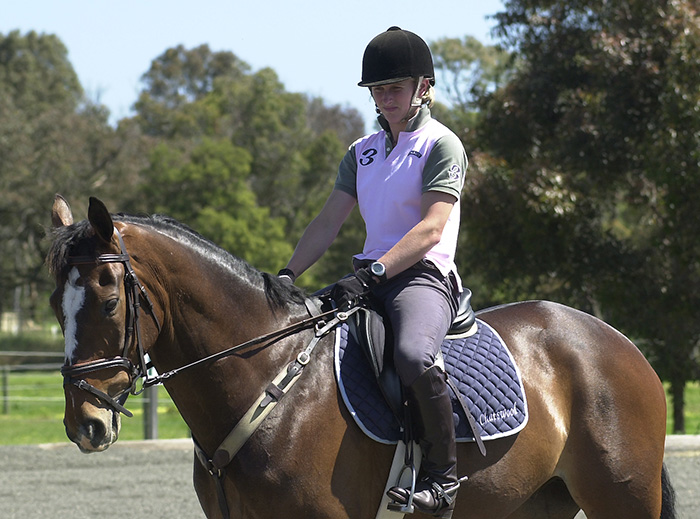
And talk…
“Looking at him now, there is not enough lowering for my liking. It is not as if he is not on the bit, it is not as if he is not stretching his back muscles to a degree – but those fingers have not reached his toes yet and with a serious athlete, their palm is on the ground, not just the tips of their fingers. He hasn’t got there yet. As a result, even though he might be quite athletic, he is not quite as elastic as the others who can put their palms on the ground and you might just catch your toe over that hurdle because you haven’t been able to stretch quite enough one way.”
more about showjumping follows
“We saw that in Adelaide in the showjumping when he rolled the rails with his backlegs. That was a sign of him not basculing, not rounding enough over the fences, and when I see his lack of reach, I can understand where that problem is coming from.”
“To go back to our analogy with the kite, it is a fairly fancy kite with a number of strings, and we are going to need a fair breeze – in other words you’ve got to have the horse nicely forward before you can expect the contact to create roundness. If you are just a happy hacker, it doesn’t matter, they don’t try to do anything to get the horse on the bit.”
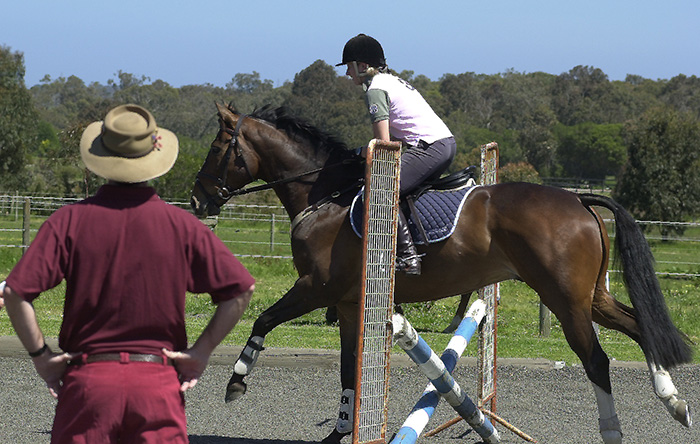
By now, I suspect it is a relief for Natalie to actually have a jump to aim at:
“Now we’ll trot over this little cross rail, just to warm the horse up a bit, take him over in both directions, one each way.”
Once again, Rex, has major spook on spectators: “Inside leg, inside leg, whenever they shy at something like that, use the inside leg a bit more!”
“The other thing I warned you I might be looking at, was whether you were allowing enough with your hands. I was watching your hands quite carefully then, and I know it is only a little fence, but I did not see your hands move up the crest of his neck. Try it again…”
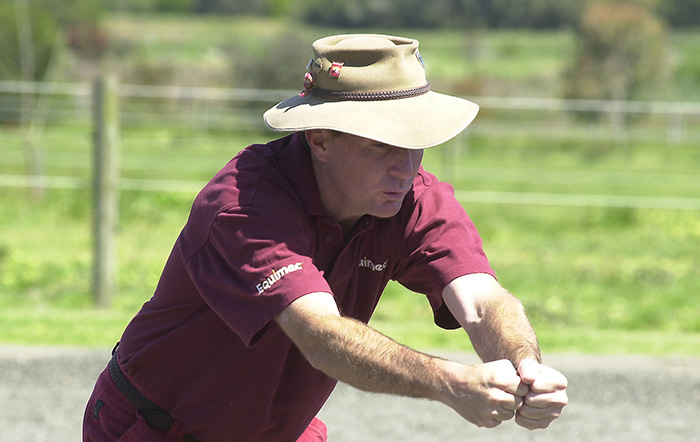
“That was a little better but don’t misinterpret the hands moving as the body moving. Try to make your reins a little longer, so you can give the reins without your shoulders having to move.”
As always, Matthew is still demanding max quality on the flat:
“In between the fences, you should be doing everything to get the horse round, to influence the use of his body. On take off, soften those hands a bit more. You’ve done all you can – you can’t actually lift them off the ground with your hands. Quite often when riders go ‘Hup’ with the hands all they do is make the horse go more hollow. You have to soften your hands. The last stride as the horse puts its feet down in front of the fence, is like a medium trot feeling, you should allow the horse to lower and lengthen. Ideally in front of the fence – like a medium trot – you shouldn’t drop the contact, but to have that ideal contact in front of a fence is so so SO difficult, that I advocate dropping the reins. Sometimes you might have to compromise.”
“With the Thoroughbreds, if you overdo that contact just a whisker, you offend them so much that they actually jump worse. With the more crossbred horse – Irish Draught, Cleveland, Andalusian, Warmblood – because they are a bit more docile, the extra contact in front of the fence is not so offensive to them. For contact to become not so offensive, you need to have taught them to respond correctly. When you take up a contact, as long as you are forward, they should melt into your contact, into the hand. No matter how well your horse is schooled on the flat, when you add the adrenaline of coming into a fence, quite often the schooling goes out the window. I would rather see a softer rein to the point where it is loose. I probably shouldn’t be saying that, but if I had to waiver one way – too much hold or too much rein, I’d go too much rein.”
“Be careful though – more rein does not mean throw the body forward. Whenever you see someone lose balance, it is always forward into the danger zone. The last thing you want to do is creep out into that danger zone with your upper body. Against all the classic rules of showjumping, I’m looking for a longer rein rather than a shorter rein. The shorter the rein, the more necessary it is for your body to go forward to give. If I have the rein longer, I can shove my hands forward without my upper body budging, so I stay safe in my upper body – that becomes particularly important cross country, not so much for straight showjumping, as an eventer you have to learn to keep your body back a touch more because of the greater danger.”
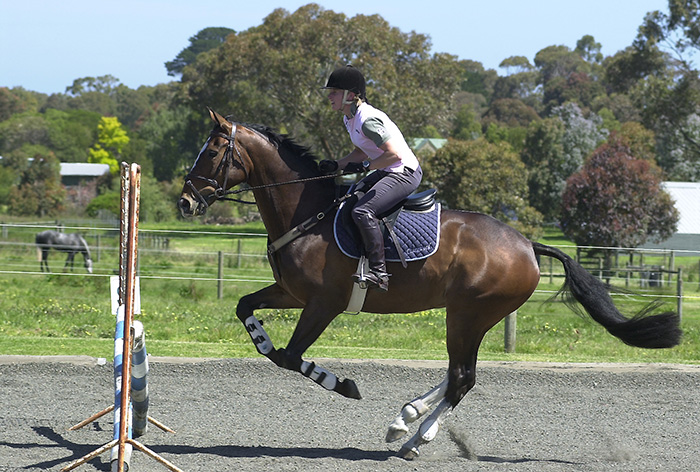
“What I am going to get you to do now is canter over the crossrail and straight up to the upright. I’m going to walk the distance, it’s got to be three strides. If you don’t get three strides that means you are not working on a true twelve-foot stride. You’ll see showjumpers do this exercise with just rails on the ground, but the reason I don’t like rails on the ground, is that if you get it wrong, nothing happens the horse just jumps the rail funnily.
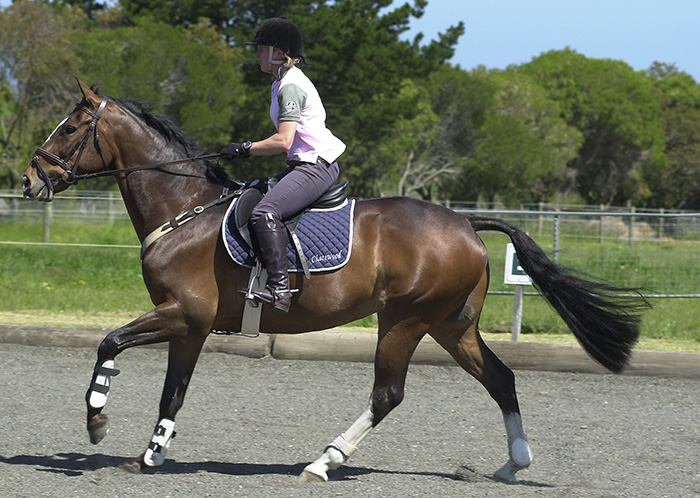
Cross rails and upright, if you don’t get it right, it is more disastrous. It puts the rider under more pressure to get it right. Rails on the ground aren’t effective enough in making the jockey actually do something about it. Starting with the cross rail, I’m not making it too difficult, just in case you don’t see a great spot here, but I am making these uprights, which force you into making the decision – move up or wait up a little.”
“Left rein, over your cross rail, three strides to the upright.”
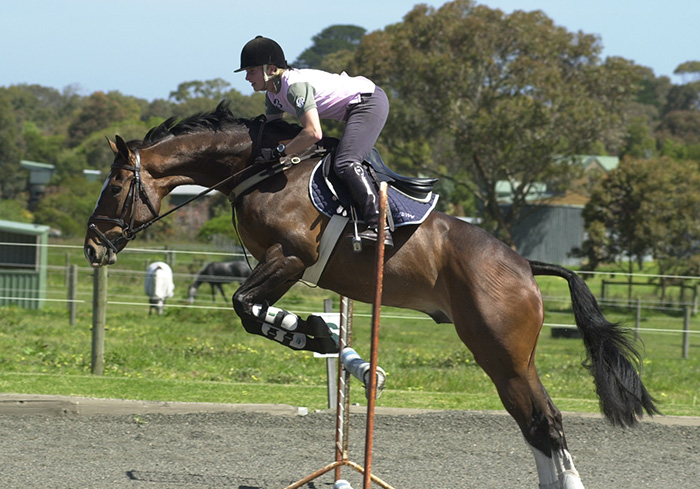
And they do it in four. And Matthew is not happy…
“Even though they may be small, we are working on 12-foot strides, I’ll let you off this time, but next time I’m not going to be so easy.”
And poor Nat, the horse still shies at that same spot:
“That’s the sponsor’s banner over there. It is a big time competition, that’s the big Grandstand over there. The horse is going to shy at them- TOUGH. Cope with it!”
Past the spectators, Nat and Rex still have Matthew’s fences to deal with…
“HOW MANY STRIDES DID YOU DO?”
“Four.”
“HOW MANY STRIDES WAS IT MEANT TO BE??”
“Three.”
“The first time you did it was four strides almost easily, almost comfortably, a little bit short. What should have gone through your mind?”
“A bit more canter.”
“A LOT MORE CANTER! What did you do when you went into that cross rail? You shortened up to try and see your spot to that cross rail and that is the last thing you needed to do when YOU KNEW that your feeling was too short already. Come down this long side saying, I must have a big canter. I don’t care if they spook at the sponsor’s sign, it shouldn’t matter if they spook at the Grandstand where there are 20,000 people watching you, you’ve got to cope, you’ve got to think, I’ve got to get that canter going, you’ve already stuffed up that distance twice, so the last thing you want to do is shorten up, you want to move out, you want to increase your pace.”
“I need you to think about coming into that cross rail faster than you think is required. LET’S GO!!! LET’S GO!!! LET’S GO!!! MOVE!!!!!”
This time, Nat gets her three strides, but Matt, being Matt, is not entirely happy: ‘The ideal take off point for this fence is somewhere between one and two yards. You took off further away than that, although you did three strides you were still quite a way from the fence when you took off. Did you feel that? I would like to see you getting deep to that fence, try to make it uncomfortable because you have over-ridden it. Let’s go. KICK KICK KICK. Try again.”
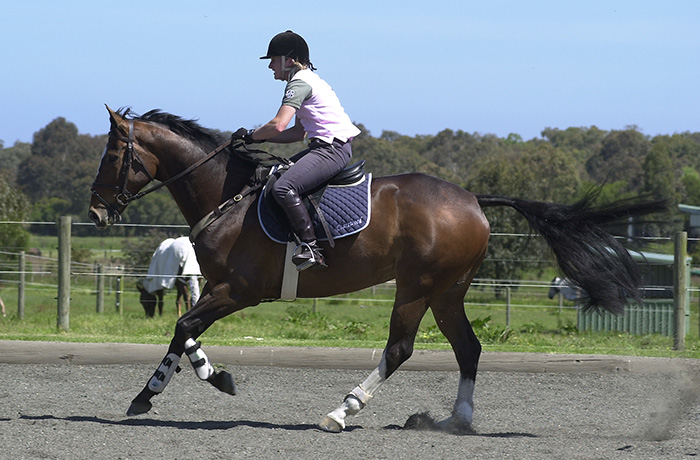
This time the three strides comes up better:
“Good girl. By no means was that deep but that was definitely better. It will start to seem right in three, you’ll be wondering, bloody hell, how did I put four in there. You’ve got to learn to travel at a 12-foot stride and you’ve got to be able to see that distance from there.”
“Now we are going to go to the four stride distance which is a little bit more difficult because there is a bend in it. We are looking for four strides in that same ground covering canter, work on it. Think of that good healthy 12-foot canter stride. COME ON!”
“Although it gets difficult for you every time in the corner, I am putting that aside, it’s a distraction, but something you’ve got to handle. From now on I want you to count to put you into a bit of a rhythm. If you do it quite often, then you’ll come into a fence and automatically start counting your strides out, four, three, two, one. Even though he is spooking, I need you to be able to see a good spot there.”
“The next distance is a six stride distance. Think of your 12-foot stride. That’s better that’s more like it. There were good bits and bad bits about that. You didn’t see a great spot to your first element, but you recognized that to a degree and you pushed on a little bit, but how accurate do you think you were to that second fence?”
“A bit off it.”
“As long as you realize it. If you don’t get a great spot to the first one, remember that the acceleration you made in there was not enough.”
By now poor Nat is counting aloud.
“That time, you didn’t miss on the first fence so you thought ‘I’m fine’ – and you weren’t! You need to think of a bigger canter, kick him, GO, 12-foot canter, GO! It should be easier to adjust your stride in bigger distances because you’ve got more time to do something.”
“Always think shoulder in when you are going past something spooky. Don’t try to flex thehorse towards what he is shying at. When you go to shoulderin, you might momentarily think he’s coming into the arena, that shoulder in will give you more control.”
“It almost looks to me as if you are trying to get the horse too nice between your fences, you are trying to keep a contact, trying to get the horse to go rounder, in that distance, I know earlier I did say try to get the horse as round as you can between the fences, so hopefully that will influence his shape over the fence but unfortunately this contact that we are using to get the horse round is also a braking system, so your attempt to get a better quality canter is putting the brakes on. You’ve got to prioritize things. The priority here is to cover enough ground to meet that fence correctly, then gradually once you get the feel of that 12-foot canter stride, then you can add things to it.”
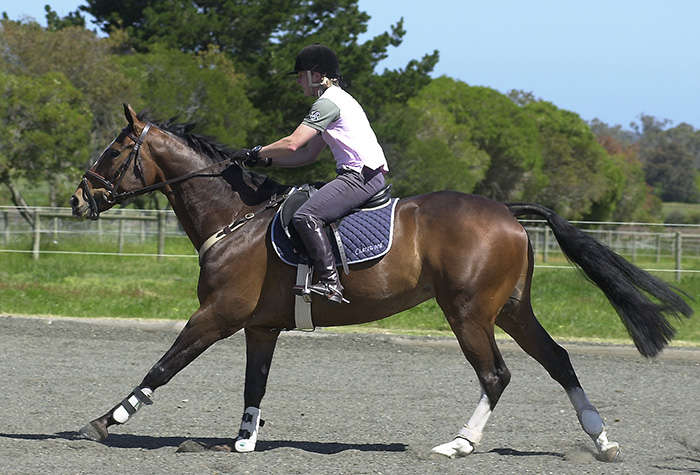
“I haven’t said one thing to you about your position. I’d like to, but I am not prioritizing your position, I am prioritizing you trying to cover the correct amount of ground to meet that fence at the right spot – which is what was the reason for 50% of your faults in that showjumping round in Adelaide. It takes a lot more skill to get a horse properly on the bit, than it does to merely put your leg on and cover a bit more ground. You could say, 50% was because I didn’t see a nice spot, but 50% was because the horse wasn’t round enough – it is easy to eliminate the first 50% by seeing better spots.”
“It is more difficult to get the horse rounder, and this horse might never come round, he might be one of these horses which really are very stiff: his fingers might never touch the ground. I think he does have that capacity, but our first priority is getting him so he covers enough ground to make the distances work. I want you to cover enough ground to meet the next fence at the right stride. You looked like you were trying to do more in there than just that.”
”I’m not saying throw the reins away and let him go anywhere. I still need you to have a certain amount of contact to make sure you keep him straight but it looks like you are trying to do too much in there, rather than just work on a 12-foot canter stride.”
“We all have our comfort zone, and obviously where I am going with you – this 12-foot stride – is outside your comfort zone and you are really not comfortable riding a canter that covers that much ground. You’ve got to try to incorporate that canter into your comfort zone. You’ll only do that if you practice these distances that you will find in your competitions, you’ve got to have those lines as part of your comfort zone. You don’t want rails down because you squeezed in an extra stride that wasn’t really there. No matter how uncomfortable this feels initially, you’ve got to go outside your comfort zone and play with this, and once you play with it enough, it will become part of your comfort zone.”
It was, as you will have noticed by now, a great lesson, and the best thing was, when I saw Nat a week later, she was beaming. “I went home and rode all my horses like Matthew said, and went to a competition on Sunday, and they have never jumped so well before. I’m rapt.”
